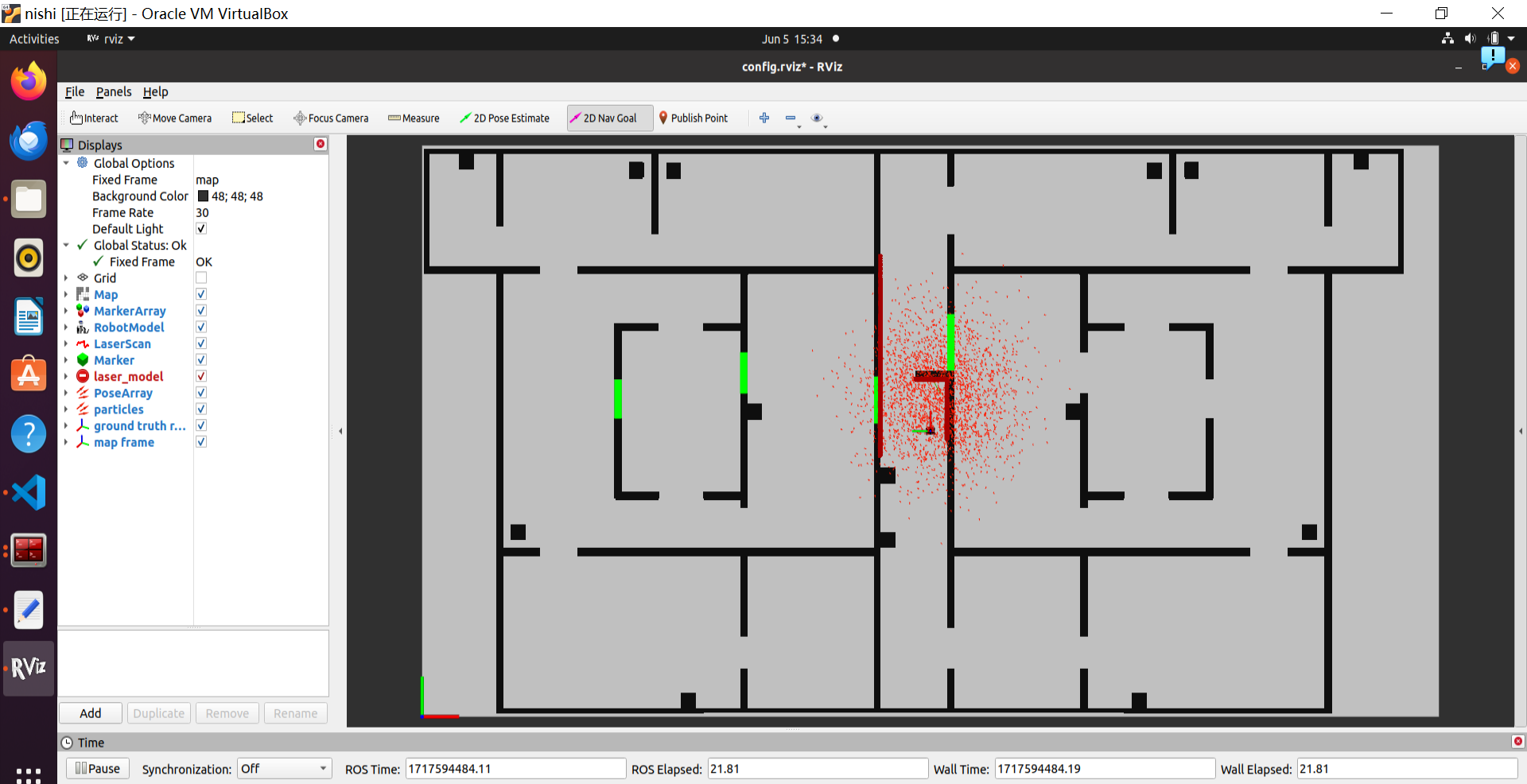Mobile Robot Control 2024 Ultron:Solution 4: Difference between revisions
| Line 25: | Line 25: | ||
==== 1.1 Initialize the Particle Filter ==== | ==== 1.1 Initialize the Particle Filter ==== | ||
[[File:1 1Initialize the Particle Filter.png|alt=Initialize the Particle Filter|thumb]] | |||
'''1. What are the advantages/disadvantages of using the first constructor, what are the advantages/disadvantages of the second one?''' | '''1. What are the advantages/disadvantages of using the first constructor, what are the advantages/disadvantages of the second one?''' | ||
*First Constructor (Uniform Distribution) | *First Constructor (Uniform Distribution) | ||
Revision as of 15:43, 5 June 2024
0. Assignment introduction
0.1 Explore the code framework
1.How is the code is structured?
- The code for this assignment is organized into multiple classes, with each object or component having its own class and functions that allow for modifying its specific aspects.
2.What is the difference between the ParticleFilter and ParticleFilterBase classes, and how are they related to each other?
- Differences:
ParticleFilterBaseprovides the basic functionalities and interfaces of the particle filter, including particle initialization, propagation, weight computation, and setting resampling strategies.ParticleFilterinherits fromParticleFilterBaseand implements specific update and resampling strategies. It extends the base class by providing concrete implementations for theupdateandconfigureResamplermethods.
- Relationship:
ParticleFilteris a subclass ofParticleFilterBase, inheriting all its attributes and methods while overriding or extending some of them to provide additional functionalities.
3.How are the ParticleFilter and Particle class related to eachother?
- The
ParticleFilterclass manages and utilizes a set ofParticleinstances for filtering operations. It inherits fromParticleFilterBaseand implements particle propagation, weight calculation, and resampling by invoking methods onParticleobjects.ParticleFilterinitializes particles, propagates their states based on odometry data, calculates weights from sensor measurements, and resamples according to the configured strategy. TheParticleclass encapsulates the attributes and behaviors of individual particles, such as state initialization, propagation, and likelihood computation.ParticleFiltercoordinates the filtering process, whileParticlerepresents and updates individual states.
4.Both the ParticleFilterBase and Particle classes implement a propagation method. What is the difference between the methods?
- The
propagateSamplesmethod in theParticleFilterBaseclass propagates all particles, typically called in the main loop of the particle filter to update the state of all particles. In contrast, thepropagateSamplemethod in theParticleclass propagates a single particle, usually invoked by thepropagateSamplesmethod inParticleFilterBase, to update the state of a specific particle.
1. Assignments for the first week
1.1 Initialize the Particle Filter
1. What are the advantages/disadvantages of using the first constructor, what are the advantages/disadvantages of the second one?
- First Constructor (Uniform Distribution)
- Advantages:
- Broad Coverage: Ensures all possible states are considered, making it suitable for completely unknown initial states.
- Disadvantages:
- Inefficiency: In known environments, it can be inefficient as many particles may be placed in irrelevant areas.
- Slower Convergence: May take longer to converge to the true state, especially in large environments.
- Advantages:
- Second Constructor (Gaussian Distribution)
- Advantages:
- Focused Search: Particles are concentrated around a known mean, leading to faster convergence.
- Efficiency: More efficient in scenarios with some prior knowledge of the initial state, placing particles where they are more likely to find the true state quickly.
- Disadvantages:
- Assumption Dependency: Relies on having a reasonable estimate of the initial state. Incorrect initial mean can lead to incorrect convergence.
- Limited Coverage: Might miss the true state if it lies outside the initial Gaussian distribution.
- Advantages:
2. In which cases would we use either of them?
- When choosing between constructors, it depends on the application's context and the knowledge of the initial state. Use the first constructor (uniform distribution) when the initial state is completely unknown, such as at system startup or in a complex, unknown environment, as it ensures broad coverage. Use the second constructor (Gaussian distribution) when there is prior knowledge of the initial state, such as in tracking known targets or when previous state estimates are available, as it allows for focused and efficient search, leading to faster convergence.
1.2 Calculate the pose estimate
1. Interpret the resulting filter average. What does it resemble? Is the estimated robot pose correct? Why?
2. Imagine a case in which the filter average is inadequate for determining the robot position.
1.3 Propagate the particles with odometry
1. Why do we need to inject noise into the propagation when the received odometry infromation already has an unkown noise component?
2. What happens when we stop here, and do not incorporate a correction step?
2. Assignment for the second week
2.1 Correct the particles with LiDAR
1. What does each of the component of the measurement model represent, and why is each necessary.
2. With each particle having N >> 1 rays, and each likelihood being ∈ [0, 1], where could you see an issue given our current implementation of the likelihood computation.
2.2 Re-sample the particles
1. What are the benefits and disadvantages of both the multinomial resampling and the stratified resampling?
2. With each particle having N >> 1 rays, and each likelihood being ∈ [0, 1], where could you see an issue given our current implementation of the likelihood computation?
2.3 Test on the physical setup
1. How you tuned the parameters.
2. How accurate your localization is, and whether this will be sufficient for the final challenge.
3. How your algorithm responds to unmodeled obstacles.
4. Whether your algorithm is sufficiently fast and accurate for the final challenge.
